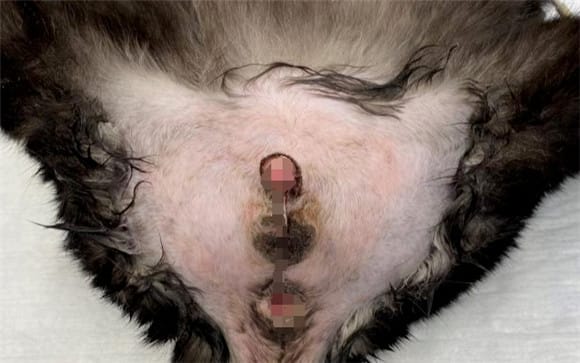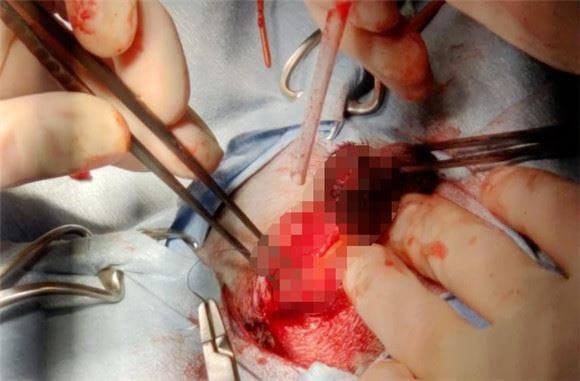1. Indications of perineal urethrostomy
"Urethrostomy" refers to the creation of a new, permanent opening in the urethra. The perineal region is the most common location for a urethrostomy in cats, allowing urine to drain from a normal anatomical area with a larger diameter than the natural urethral opening. Alternative urethrostomy (modified surgical) locations include prepubic, infrapubic, and transpelvic locations; however, these procedures are only used when the lesion is in the urethra rostral to the bulbourethral gland. The surgical site for all feline urethrostomies is at the level of the bulbourethral gland or cephalad because the diameter of the feline urethra tapers from cranial to caudal. The average inner diameter of the preprostatic urethra and postprostatic urethra is 2 mm, the urethra at the bulbourethral gland is 1.3 mm, and the distal urethra is 0.7 mm. Perineal urethrostomy is most commonly performed as part of the treatment of feline lower urinary tract disease (FLUTD), but may also be used to treat distal urethral trauma, strictures, tumors, or congenital anomalies. When other causes of urethral obstruction in FLUTD have been ruled out and recurrent urethral obstruction occurs despite appropriate management, a perineal urethrostomy may be required.

2. Surgical steps
1. Animals You can lie on your back or prone. Regardless of the positioning, the animal's head is facing the anesthesia machine and the perineal area is at the other end of the operating table to minimize the distance between the animal and the surgeon. The anus is purse-string sutured to minimize intraoperative fecal contamination. While lying on your back, you should place your legs gently over your head and sides to maximize exposure of the perineal area. While lying prone, the animal's hind limbs are suspended from the end of the table and the tail is placed gently over the back to maximize exposure of the perineal area. Pads can be placed under the waist (when supine) or abdomen (when prone) to support the animal and elevate the perineal area.
Some animals require concurrent cystotomy, in which case the supine position is advocated to avoid re-settling or changing the animal's position, but there is no difference in surgical complication rates, surgical or anesthesia duration between different positions. significant difference. Twenty-four hours after surgery, animals generally had reduced perineal reflex activity and increased incidence of spinal pain; however, there were no differences in incidence between positions.
2. The perineal area is shaved and prepared aseptically for surgery. If a concurrent cystotomy is planned, the animal can be placed in the supine position. The abdomen is shaved, sterilized and draped in the same surgical area to avoid re-baptism. If possible, a urinary catheter should be placed before starting surgery to help identify the anatomic location of the lower urinary tract.
3. Use a scalpel to make an oval incision around the scrotum and foreskin. Male cats are routinely castrated. The distal end of the penis and/or foreskin can be grasped with Allis tissue forceps to facilitate dissection. Using a combination of sharp and blunt dissection, the penis is separated and circumferentially dissected to the insertion of the ischiocavernosus muscle. Monopolar and/or bipolar electrosurgery can help minimize bleeding during dissection.
4. Elevate the bilateral ischiocavernosus muscles from the ischial position. Electrocautery or a scalpel can help elevate the origin of the ischiocavernosus muscle and then use a periosteal stripper to fully elevate it to minimize the risk of muscle bleeding. Release of the ischiocavernosus muscles exposes the ventral penile ligament, which is then transected at the insertion of the ventral and central portion of the penis. Continue to circumferentially dissect the penis from the subcutaneous tissue and sharply transect the penile contractile muscles from the dorsal side of the penis (Figure 4). Continue circular dissection until the bulbourethral gland is exposed. The bulbourethral gland is easiest to see and palpate on the dorsal aspect of the penis and is located cephalad of the transected ischiocavernosus muscle.

5. Once the penis is fully dissected, use a razor blade or tendon scissors. Incise the distal tip of the penile urethra to the bulbourethral gland. Failure to incise the urethra far enough cephalad limits the size of the urethrostomy site and increases the risk of stricture formation. If a urinary catheter cannot be placed preoperatively due to obstruction, a urinary catheter should be placed after the urethral incision to help guide the urethrostomy. Studies have shown that the urethrostomy lumen diameter decreases by an average of 0.15 ± 0.09 mm 12 days after surgery, so the urethrostomy site should be large enough to withstand this expected narrowing that will occur during the natural healing process.
According to relevant studies, urethrostomy that can easily accommodate a 10Fr red rubber catheter has a 6% chance of developing obstructive stricture, while urethrostomy that can maximally accommodate an 8Fr or 6Fr catheter has a 44% chance of developing obstructive stenosis. and 100% chance of developing obstructive stenosis.
The urethral mucosa is sutured to the surrounding skin to form a urethrostomy. Any tension at the stoma site should be avoided to minimize the risk of stoma dehiscence and excessive stenosis. While non-absorbable sutures (e.g., nylon thread) and slowly absorbable sutures (e.g., polydioxanone) can be used, rapidly absorbing sutures (e.g., polycapron 25) have been shown to be safe , and no suture removal is required. Simple interrupted sutures or horizontal mattress sutures on the dorsal range of the urethrostomy site or at the 12 o'clock position can maintain the proper direction of the stoma and avoid urethral dislocation. Placing simple interrupted sutures on both sides of the urethrostomy can gradually promote the formation of the opening and avoid tension on both sides. The 10Fr catheter can be left in place during the stoma procedure to ensure adequate size.
Alternatively, depending on the surgeon's preference, the catheter can be placed intermittently during the stoma to find the appropriate diameter. You can use about 1 cm of the remaining penis urethra as a "washboard". Suture this 1 cm strip of penile mucosa to the surrounding skin using simple interrupted sutures or simple continuous sutures. This minimizes tension in the area and minimizes the chance of urine-induced dermatitis. After the "washboard" is created, any remaining penile tissue is ligated using either circumferential or percutaneous ligation and then amputated. Final sutures are placed in either corner of the distal extent of the "washboard," and the remaining skin is closed conventionally in two layers (subcutaneous tissue and skin).
3. Results
Although 81.8% to 100% of cases have good to excellent long-term results, it should be remembered that perineal urethrostomy is a rescue surgery. Pet owners should be informed that perineal urethrostomy can be used to treat FLUTD, but it does not cure the disease. Approximately 54% of cats develop short-term complications, with urinary tract obstruction and urethrostomy site stenosis reported in up to 20% of affected animals at a mean of 92 ± 25 days postoperatively. Sterile cystitis and urinary tract infection are the most common short- and long-term complications; however, other less common short-term complications reported in the literature include urinary incontinence, recurrent obstruction, stricture, extravasation of urine into the perineal subcutaneous tissue, and local dermatitis. Mild long-term complications are uncommon; however, 13.5% to 39% of animals develop recurrent sterile cystitis and/or urinary tract infections consistent with FLUTD. Although some affected animals are subclinical, 77.2% of cats develop bacteriuria within 12 to 24 months after perineal urethrostomy surgery.
In conclusion, perineal urethrostomy is a common treatment for feline lower urinary tract disease. Although the short-term complication rate of this procedure is quite high, its long-term success rate is high. It has been consistently shown to improve the quality of life of affected cats.

 扫一扫微信交流
扫一扫微信交流
发布评论